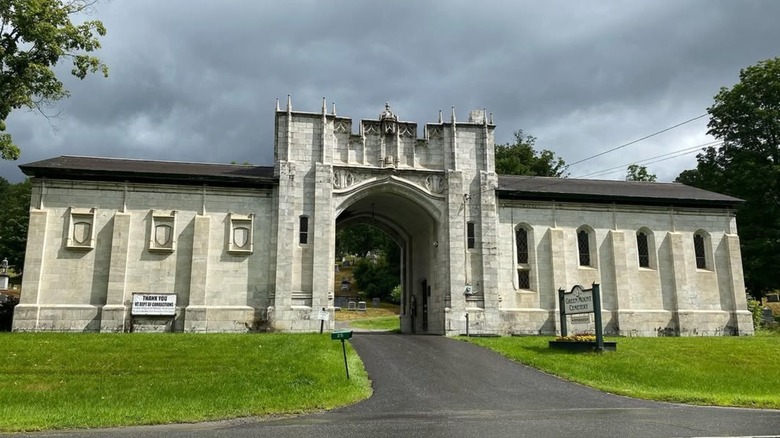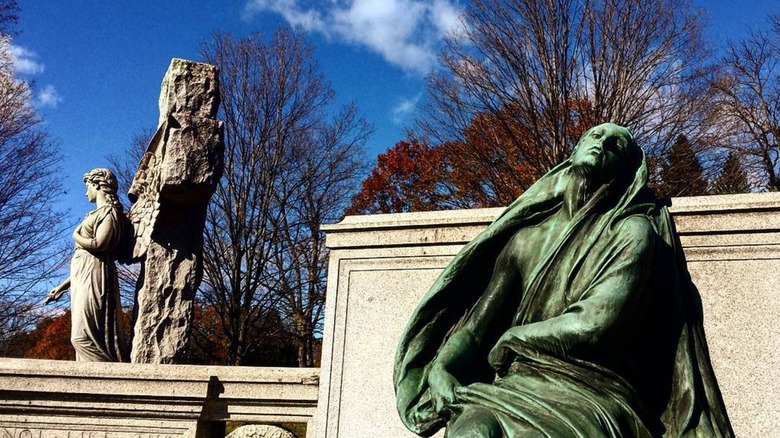Take A Peaceful Journey Through Vermont's Past, Where Stories Meet Picturesque Hillside Views
Montpelier might be America's smallest state capital, but this charming Vermont city is big on culture, history, and lush natural beauty, along with boasting look-a-like French landscapes and a vibrant food scene. Beholding the city's gold-domed State House, sweeping through the Vermont History Museum, and grabbing gourmet goodies at the Capital City Farmer's Market are a must, but one of Montpelier's best discoveries lures visitors off the beaten path. Enter the unlikely Green Mount Cemetery, where you can take a peaceful journey through Vermont's past through stories spun by fascinating funerary art set amongst picturesque, hillside views.
Nestled along the Winooski River off Highway 2, just five minutes south of Hubbard Park, Green Mount Cemetery makes an excellent stop on your next scenic Vermont road trip. In fact, the cemetery's narrow, serpentine streets sprawl over 35 terraced acres, making it a unique road trip in its own right. Drive through the hulking stone entrance and continue along Green Mount's 2.5 miles of winding roads. A verdant, rolling hillside dappled with a diverse array of sculptural funerary art stretches out before you. Naturally, mourners are drawn to these artistic plots, but so too are visitors impressed enough to leave glowing online reviews. "Very well kept cemetery and beautiful views from the top on a clear day," writes one visitor on Tripadvisor.
Start your funeral march by stopping at the entrance for a handy cemetery map, which also includes suggestions for a walking tour. Just take note that the terrain can be challenging whether you choose to walk or drive. "It's a very hilly cemetery to walk through, and it's not easy to drive through either due to several narrow lanes with little ditches on either side," advises one Tripadvisor comment.
Spooky tales from Green Mount Cemetery
One of Green Mount Cemetery's most famous sculptures is a billowy-robed figure known as Black Agnes. The graceful sculpture adorns the gravesite of wealthy Vermont businessman, John Hubbard. Although the bronze artwork derives its name from a blackish discoloration, many believe it's because it's haunted, like this mystical tomb in New Orleans's oldest cemetery. Apparently, visitors who sit in Agnes' lap at midnight are doomed. "Legend says that "grave bad luck" and even death befalls all who do," cautions one spooky Tripadvisor review." In reality, the solemn sculpture doesn't depict a woman named Agnes at all. It's Thanatos, a Greek deity representing death.
Black Agnes was sculpted by the prominent 19th-century sculptor Karl Bitter, who also fashioned the sarcophagus of a New York attorney named Friedrich Dieter. Dieter's granite tomb portrays the harrowing scene of the Virgin Mary hovering over the prostrate body of her son, Jesus. Also noteworthy is Bitter's "Stairway to Heaven" floating above the gravesite of William Stowell. The staircase, commissioned by Stowell for his family burial plot, was hand-carved by hammer and chisel. The grave's granite steps emerge from the earth and then level off, ultimately leading to nowhere.
A pair of moving memorials carved by Vermont artist Harry J. Bertoli memorializes children gone too soon. The statue known as "Little Margaret" commemorates a young girl named Margaret Pitkin who died of meningitis in 1899. Her family furnished Bertoli with a picture of Margaret and requested her funerary sculpture appear exactly as their child in the photograph. When the statue was revealed with a missing button on Margaret's shoe, the family refused to pay Bertoli. Bertoli also sculpted the piece known as Ned the Dog, the favorite, bow-tie-wearing pet of Fred Stevens, who died at 17.

